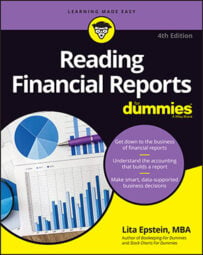The management's discussion and analysis (MD&A) section is one of the most important sections of an annual report. The MD&A may not be the most fun section to look at, but in it you find the key discussions about what went smoothly over the year and what went wrong.
Read the MD&A section carefully. It has a lot information that gives you details about how the company's doing.
The Securities and Exchange Commission (SEC) monitors the MD&A section closely to make sure that companies present all critical information about current operations, capital, and liquidity. Management must also include forward-looking statements about known market and economic trends that may impact the company's liquidity and material events, as well as uncertainties that may cause reported information to not necessarily reflect future operating results or future financial conditions.
For example, if a company manufactures its products in a country that's facing political upheaval or labor strife, those conditions may impact the company's ability to continue manufacturing its products at the same low cost. The company must report this information, indicating how this situation may impact its future earning potential.
The SEC pays special attention to a number of key factors that the MD&A is supposed to cover:
Revenue recognition: In a retail store, recognizing revenue can be a relatively straightforward process: A customer buys a product off the shelves, and the revenue is recognized or recorded in the company's books. But matters aren't that cut-and-dried in many complex corporate deals.
For example, in the computer and hardware industries, revenue recognition can be complex because purchase contracts frequently include multiple parts, such as software, hardware, services, and training. When a company actually recognizes the revenue for each of these parts can vary, depending on the terms of a contract.
When reading financial reports for a particular industry, reviewing how management describes its revenue-recognition process compared to similar companies in the same industry is important.
Restructuring charges: When a company restructures a portion of itself — which can include shutting down factories or enacting other major changes related to how the company operates — management discusses the impact this had on the company. This portion of the report explains costs for employee severance, facility shutdowns, and other expenses related to restructuring.
Impairments to assets: The SEC expects companies to report any losses to assets in a timely manner. If an asset is damaged or destroyed, or for any reason loses value, companies must report that loss to shareholders. Look for information about the loss of value to assets in the MD&A. Also look for information about the depreciation or amortization of these assets.
Pension plans: Accounting for pension plans includes many assumptions, such as the amount of interest or other gains the company expects to make on the assets it holds in its pension plans and the expenses the company anticipates paying out when employees retire. If the company has a pension plan for its employees, you'll find a discussion about how the company finances this plan.
Environmental and product liabilities: All companies face some liability for products that fail to operate as expected or products that may cause damage to an individual or property. In some industries — such as oil, gas, and chemicals — an error can cause considerable environmental damage.
In the MD&A section, the company must acknowledge the liabilities it faces and the way it prepares financially for the possibility of taking a loss after paying the liability. The company must estimate its potential losses and disclose the amount of money it has set aside or the insurance it has to protect against such losses.
Stock-based compensation: To attract and keep top executives, many companies offer stock incentives as part of an employee compensation package. This part of the annual report must mention details of any stock-based compensation. Many recent scandals have included disclosures of unusually lavish stock-based compensation programs for top executives.
Keep a watchful eye` out for discussion of bonuses or other employee compensation that involves giving employees shares of stock or selling employees’ shares of stock below the market value.
Allowance for doubtful accounts: Any company that offers credit to customers will encounter some nonpayers in the group. Management must discuss what it allows for loss on accounts that aren't paid and whether this allowance increased or decreased from the previous year. An increase in the allowance for doubtful accounts may indicate a problem with collections or be a sign of significant problems in the industry as a whole.
The discussion in this section of the annual report can get technical. If you don't understand what you read, you can always make a call to the investor relations department to ask for clarification. Whenever you're considering a major investment in a company's stock, be certain that you understand the key points in the MD&A.
In the MD&A, managers focus on three key areas: company operations, capital resources, and liquidity.
Management commentary on this topic focuses on the income the company's operations generate and the expenses related to them. To get an idea of how well the company may perform in the future, look for the following:
Discussion about whether sales increased or decreased
Details on how well the company's various product lines performed
Explanations of economic or market conditions that may have impacted the company's performance
The MD&A section also discusses these areas:
Distribution systems: How products are distributed.
Product improvements: Changes to products that improve their performance or appearance.
Manufacturing capacity: The number of manufacturing plants and their production capability. The MD&A also mentions the percentage of the company's manufacturing capacity that it's using.
Research and development projects: The research or development the business is doing to develop new products or improve current products.
The manager also comments on key profit results and how they may differ from previous projections.

